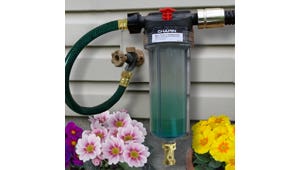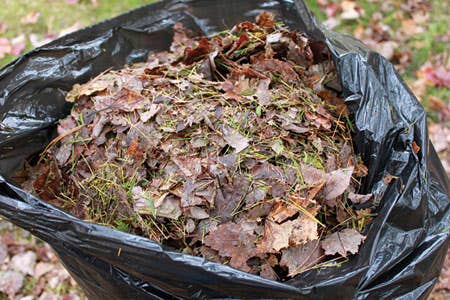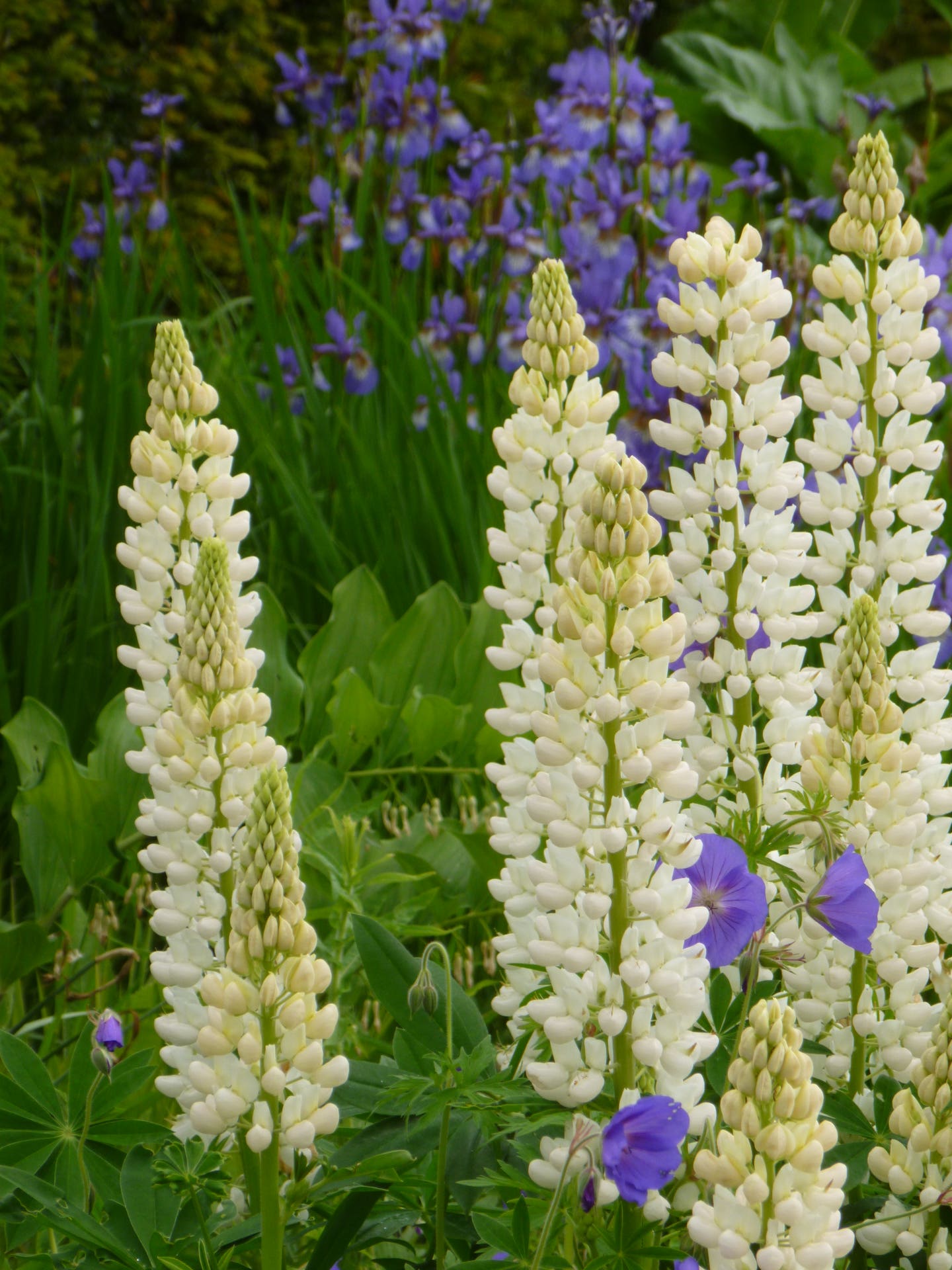A little planning will keep both you and your pet happy.
Gardeners who are strictly “cat people,” or who aren't partial to animals at all, assume that all dogs are a menace in the garden. Of course, moments occur when they are. We scream, we rant, they become remorseful—and are forgiven. Their unflagging, unquestioning companionship, as well as the animation they add to the garden—lying across its paths, rolling on its panels of lawn, sniffing the air, nosing the flowers—far outweigh any trouble they cause.
When they do cause trouble, the results are sometimes spectacular. When I was in my late twenties and first seriously gardening, with several toddlers wrapped about my knees, I had a flower border that I was immensely proud of, resplendent in June with delphiniums and campanulas. I also had a Saint Bernard named Brandy, who was a perfect garden dog. She was happy to lie quietly for hours nearby as I weeded and fussed over my flowers. That is, until she got sprayed in the face one day by a skunk. In her panic (skunk spray stings fiercely), she flung herself into the garden bed and desperately, mindlessly, rolled from side to side. I stood watching, dumbfounded, tears streaking my face, as my entire flower border was flattened in a matter of seconds. Gardeners become inured to disaster—a flash hailstorm could have caused the same demolition. I bathed Brandy in several gallons of tomato juice, and set about replanting my garden.
Having gardened for many years now with many different dogs, I know that, except for an occasional dramatic incident, you can garden compatibly with canine company as long as you're willing to train your pups with some consistency.
THE URGE TO DIG
Most dogs like to dig as much as we do, and this can cause problems. Noodle, our miniature dachshund, and Roux, our Norfolk terrier, after catching a whiff of mole or vole, like nothing better than to dig furiously with paws and snouts under the hostas, snorting with the pleasure of the hunt. I discourage them, of course, and then scrape back the mounds of earth with the side of my shoe or a shovel, but I also console myself by thinking I have fewer voles (and no woodchucks) in the garden because of their enthusiasm.
Actually, one of my dogs’ favorite places to dig is in the compost heap, which is perfectly harmless. In fact, it helps us turn over and aerate it, which is something we never seem to get around to. I admit that they end up impressively dirty, with flecks of leaf mold clinging to their whiskers. But what good exercise they've had.
COPING WITH ENERGETIC PUPS
Young dogs like to go on brief daily tears—suddenly, out-of-the-blue, ears back, tail tucked, racing full speed around the property, as though they were shot from a cannon. As a pup, my Scottish deerhound, May, attempted this in the small, mazelike garden rooms here at Duck Hill, my New York garden, streaking on her long gangly legs through openings in the hedges, careering around the edges of beds as I stood wincing, waiting to assess the damage. As she grew older, she sensed that, when loping along, she should stick to the paths, and she
TEXT AND PHOTOGRAPHS BY PAGE DICKEY
Practical Points
English landscape designer Tim Rees's King Charles spaniel, Mango
- Don't forget to provide water in the garden for your dog. In the heat of the summer, they need to drink a lot.
- If you don't want your dog underfoot all the time-maybe you're having company or your garden's open for a tour—consider having an enclosed garden just for him, as Robert Dash has for his Norfolk terrier, Barnsley, at Madoo on Long Island. Picket fencing surrounds a small yard and doghouse overrun with tiny ruby morning glories, chartreuse nicotiana, and purple Verbena bonariensis.
- Think twice about bringing home a water dog if you have an ornamental lily pool in your garden. He might wreak havoc on those pads while cooling down with a swim.
- Take your young dog regularly on a walk outside the garden (in a field, if possible, where he can run). That way, he's more apt to be quiet, even sleep, while you're busy weeding and deadheading.
- Consider giving up insecticides. I haven't sprayed my garden with chemicals for many years now—I hate the smell, but, more importantly, I am loath to jeopardize the health of my pets, or the butterflies and birds that add movement and delight to the garden scene. Yes, my roses look ratty by August, but don't everybody's? My garden is not less beautiful since I gave up chemicals, and how sweetly scented it is.—P.D.
Garden-book publisher Ngaere Macray and landscape architect David Seeler's dogs Beasly, Sponk, and Miguel rarely put a foot in a flower bed. If we dog lovers can just get through those puppy years, a canine respect for the garden invariably develops. Through our consistent admonishments and urgings, our dogs realize how much we really care about those flower beds, and settle down to keep us company.
This point was driven home recently when Penny, a young vizsla belonging to my daughter, came for a three-week visit. She was entranced with butterflies, and leapt and pounced after them right through the borders, trampling daylilies and mulleins in her wake. I really couldn't blame her for she had never been in a garden before—she was used to the mountain trails and open country of Colorado where she lives with our daughter and son-in law. And she wasn't with us long enough to teach her to stay out of the flower beds.
TRAINING AND FENCES
The bigger the dog, the more important he is to train. Our miniature dachshund and terrier can walk through the perennial beds with the lightness of a cat, and consequently, I'm lazy about disciplining them. But a dog Penny's size or bigger is going to crunch the nicotiana and snap the phlox.
Many of us who live near a busy road or have a dog with an inclination to wander, rely on an electronic pet-containment system (one brand is Invisible Fence) around our properties. The electronic collars the dogs wear trigger a beeping sound when they come within a few feet of the fence, which serves as a warning that if they come any closer, they'll receive a mild electric shock. When first installed, you walk with your dog around the perimeter of your property, allowing them to hear that beeping noise, then backing up and saying “No!” The fence keeps our dogs safely at home without any apparent enclosure. Friends of ours who have a stocky brown Labrador and a bull terrier built like a tank, both with a barreling nature, have looped a piece of this containment wire around their flower beds to keep the dogs out.
I've noticed, however, that a large percentage of gardeners choose terriers, a breed
cherished for their bitesize hardiness and spunk. But often the biggest dogs make the most mellow garden companions. Deer-hounds, wolfhounds, English mastiffs, Saint Bernards—these gentle giants become lethargic when no longer puppies, and are content to spend hours silently by our side.
WHAT TO DO ABOUT PEEING
Until recently, I've always deliberately had female dogs rather than male dogs because male dogs seem to pee everywhere and on everything. I'm rather partial to boxwood—lots of boxwood—and I don't want a dog lifting his leg on them like gateposts. My husband loves to tell the story about the laurels he planted years ago on either side of his front door. One flourished and the other sulked, and he didn't know why, until he realized that his dachshund Attila marked it every time he came in or out of the house. Circling a low wire fence around the laurel stopped the problem (Attila peed on the fencing instead), but didn't add much to the aesthetics of the front entrance. Our year-old Norfolk terrier, Roux, is a male, but happily he's so short he doesn't hit much of anything (the lower third of a pot, the woody stem of boxwood) when he lifts his leg.
Friends with male dogs say they can be taught not to mark in the garden proper. Of course, female dogs leave yellow circles where they squat on the lawn (how many times have I rushed to the rescue with a watering can to the dilute the puddles). Nevertheless, they can be trained to pee in rough grass or even on a specially chosen area of gravel.
Does all this sound like trouble? Well yes, just like children are trouble, or for that matter, gardens. If one loves gardening, all the work to care for flowers, vegetables, shrubs, and trees is worth it. We do not pass up a plant because it's demanding. Life in the garden would certainly be simpler without dogs, but, for the dog lovers among us, how empty, how dull.
For more on gardening with dogs, visit www.hortmag.com/features.
Poisonous Plants
A YOUNG DOG'S TENDENCY TO CHEW on everything can get him into trouble around house and garden plants. Many naturally contain poisonous compounds that can irritate a dog's mouth, upset his stomach, or far worse.
If you suspect that your dog has eaten a poisonous plant, “call your vet, and, if you can, take the plant with you to the vet,” says Dr. Mary C. Smith, a veterinarian with the Ambulatory and Production Medicine Clinic at Cornell University. It's the best way for your vet to determine what your dog has encountered, and take appropriate action.
The following garden and houseplants are particularly toxic to both dogs and people:
For more information on these and other poisonous plants, visit the following web sites:
http://cal.nbc.upenn.edu/poison
www.vth.colostate.edu/poisonous_plants/index







